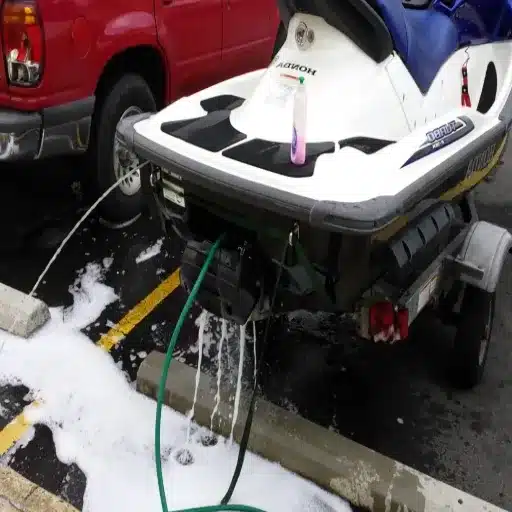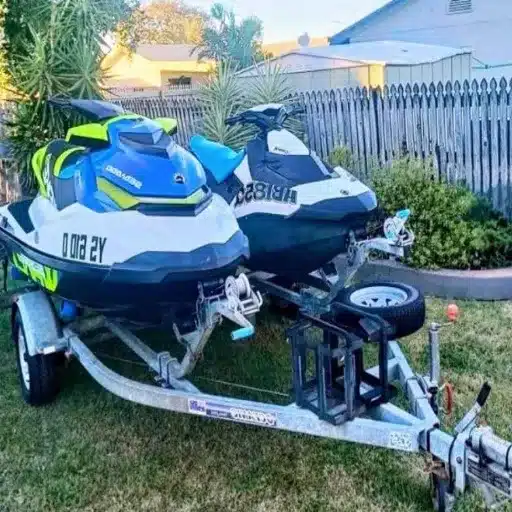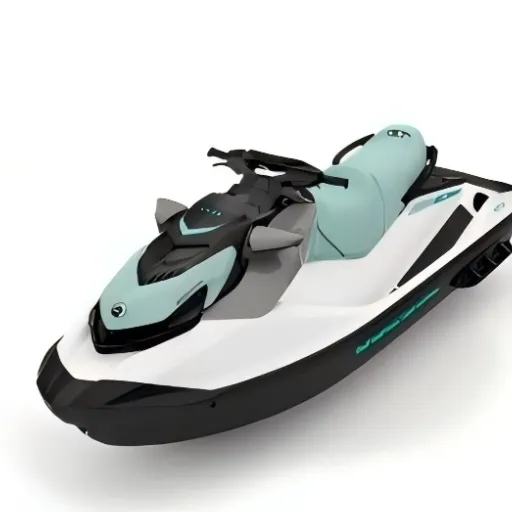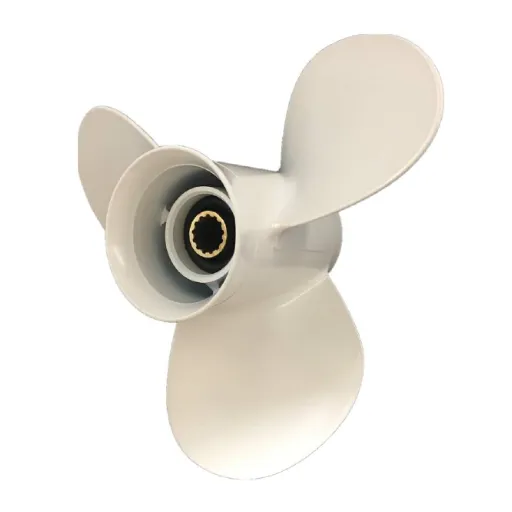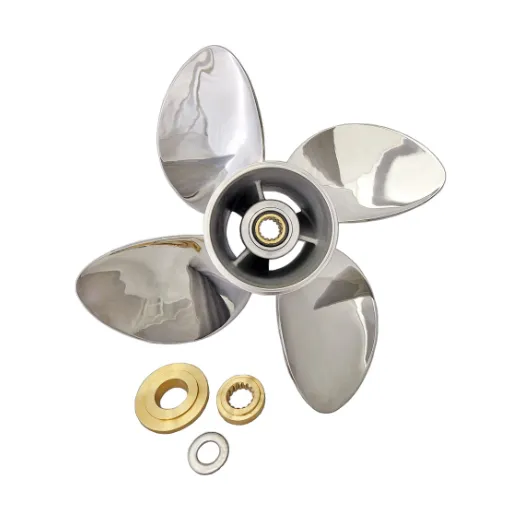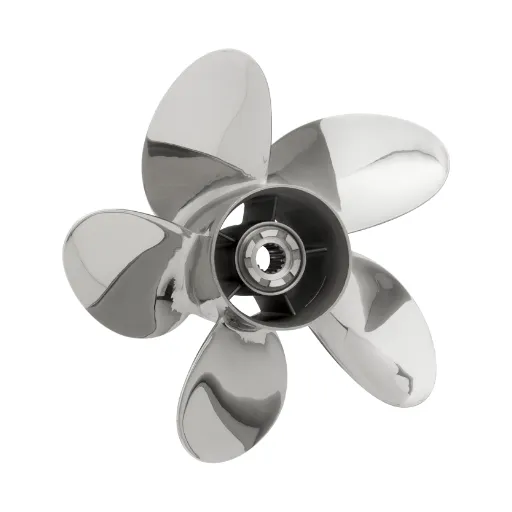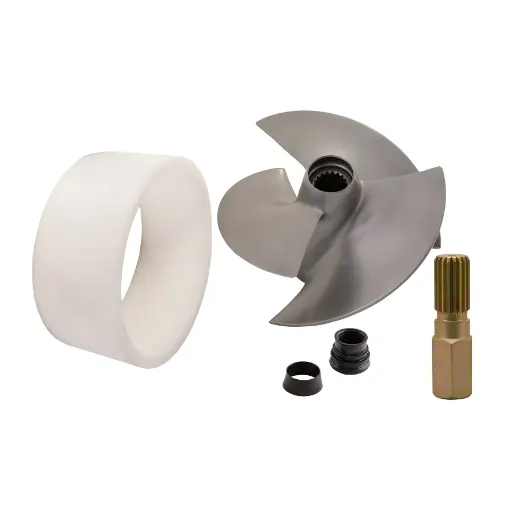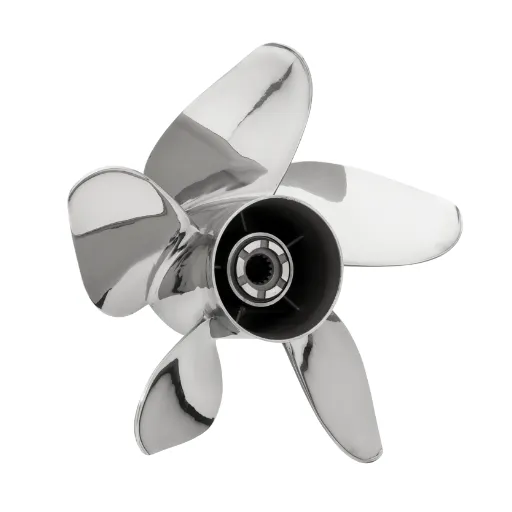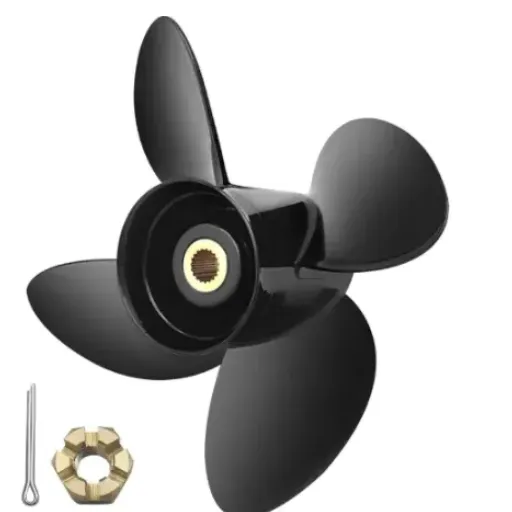Jet skis offer a great deal of thrill on the water, but maintaining one takes more than just running on fuel and casual maintenance. 2025 stands out as unique due to some technological advancements coupled with changes in environmental conditions, which create some particularly special problems and opportunities for jet ski owners to capitalize on their investment that year. This guide will walk you through a variety of expert knowledge and practical tips to help maximize the lifespan of your jet ski, keeping it running smoothly at a lower cost to you for repairs, while providing safe enjoyment for many years to come. Whether you’re an experienced flyer or a novice new to the powersport field, these insights will help you keep that jet ski just like new so that you can focus on the fun feedback riding offers while safeguarding an asset that already means a lot to you.
Understanding the Lifespan of a Jet Ski
What Affects the Lifespan of Personal Watercraft
The lifespan of a watercraft depends on several factors, including how the machine is used, maintenance, and environmental considerations. One may infer an average jet boat lifetime of 300-500 engine-hours with regular maintenance, but very few have reached beyond this during exceptional care. To ensure the maximum life of a PWC, the significant factors affecting the PWC lifespan have to be well understood:
- Maintenance and Servicing: Easy maintenance, along with periodic servicing such as oil changes, replacement of oil filters, inspection of spark plugs, and checking of impellers, can really help extend the life of a jet ski. Where scheduled service is neglected, engine wear becomes unavoidable, and performance is compromised.
- Frequency and Type of Use: Use really determines the life of a PWC. Heavy usage, and this would include high-speed rides over rough waters, exerts extra stress on the engine and the hull. Careful operation combines mechanical wear and tear, which actually prolongs the life of the equipment.
- Storage Conditions: A jet ski not stored properly under extremely harsh conditions, such as very hot weather or strong direct sunlight, will, over time, weaken the materials in the hull and seating. Ensure your ski is stored in a dry, climate-controlled area with proper covers to protect against environmental damage.
- Water Conditions: Immediately after saltwater operations, if the engines and respective metallic parts are not adequately flushed and rinsed, corrosion will set in more quickly than it would otherwise. Freshwater use can also be corrosive, particularly due to sediment buildup if the craft is not cleaned adequately.
- Build Quality and Components: The making of the jet ski from its very inception—from the raw materials used in production, down to the resources applied in the construction of its engine components—is of prime importance in determining the durability of the craft itself. Models put forth by reputable houses with high-quality components are generally resilient and stand the test of time.
Controlling these factors, coupled with strict adherence to a good maintenance schedule, will provide any jet ski owner with excellent horsepower, ensuring riding safety and fun for a very long time.
Average Lifespan of Different Jet Ski Models
The lifespan of a jet ski depends on several factors, including the manufacturer’s quality control, proper maintenance, and usage patterns. The average range of a jet ski lifespan is between 200-300 engine hours, which, if appropriately cared for and maintained, would be an average of about 10 years of use. Old watercrafts featuring high-quality materials and engineering from reputable manufacturers such as Yamaha and Sea-Doo often last a little longer than the specified duration with fewer mechanical problems.
| Manufacturer | Expected Lifespan | Key Features |
|---|---|---|
| Yamaha | 300+ engine hours | Durable engines, quality materials |
| Sea-Doo | 250-300 engine hours | Advanced technology, high-performance engines |
The engines are considered durable in Yamaha, whereas the use of quality materials sustains their performance beyond the stated life expectancy with proper maintenance. Similarly, Sea-Doo boats, equipped with advanced technology and high-performance engines, should also last as long if they are serviced regularly. They are perhaps best serviced by the owners themselves, aside from routine oil changes and voltage checks on the engines.
Usage intensity could influence the longevity of the machines. Recreational jet skiing in milder conditions may result in models lasting longer compared to their counterparts that undergo tough usage, such as high-performance activities like racing or frequent exposure to saltwater. In every case of prolonging the life span of any model, strictly following the manufacturer’s and recommended maintenance schedules, such as winterizing before storage and flushing the engine after saltwater use, is beneficial.
If these areas are taken care of, the owner will have the option to choose the model and maintain the jet ski under their care, ensuring it remains operational and reliable in the long term.
Importance of Regular Maintenance for Longevity
Regular maintenance should be done on any jet ski during its operational life. Care for the engine, maintenance of the fuel system, and hull inspection are key points to consider. Being proactive on these fronts prevents performance loss and costly repairs caused by neglect. For example, if the hull and intake grate are washed clean of debris, performance undermining or overheating may be prevented. Checking the engine by replacing worn spark plugs or ensuring it has an adequate oil level will help avoid damage accrual due to friction or contamination.
Increasingly, jet ski technologies also emphasize the importance of diagnostics and onboard monitoring systems. These systems serve as warnings to the user for potential abnormal situations, such as temperature variations or voltage drops, enabling early intervention. Statistics show that if a jet ski is serviced in accordance with the manufacturer’s recommendations, it can remain reliably operational for approximately ten years, provided it is not subjected to regular servicing. Servicing ensures that a jet ski performs well and retains resale value, and is hence a central duty a jet ski owner must undertake.
Essential Maintenance Tips for Your PWC
Creating a maintenance checklist in its complete form
To function properly and maintain efficiency over time, a PWC requires well-planned maintenance schedules. The schedule must include routine care while inspecting for the ramifications of wear, and it must implement precautionary actions where possible to reduce the risk of failure. The essentials of any good maintenance schedule are as follows:
-
#1Engine and Fuel System Inspection: Regularly check for any leaks, blockages, and corrosion in the engine and fuel system. High attention should be given to fuel lines, hoses, and clamps to ensure they remain firmly intact and have not experienced deterioration. Performance trend analysis reveals that fuel system deterioration is an overriding reason for engine-related faults in PWCs.
-
#2Cooling System Maintenance: Always flush the cooling system after each use to remove salts, sand, and other debris that may accumulate and block free water flow. Prevention of cooling system blockage is a significant issue, surveyed as a leading cause of PWC failure due to overheating and directly impacting engine life.
-
#3Battery Health Check: The battery should be checked for proper charge levels, and the terminals should be cleaned frequently to prevent corrosion. A recommended measure is to use a multimeter to see the battery output, for slight fluctuations can pinpoint a more serious electrical problem.
-
#4Hull and Exterior Inspection: Look for cracks, chips, or any damage to the hull that may interfere with either buoyancy or hydrodynamics. A foul exterior also encourages long-term abrasion of the finish by sand or grime, limiting overall performance.
-
#5Oil and Lubrication: The oil and oil filter need to be changed on a regular schedule, after 50 hours of engine operation or as specified by the manufacturer. Ensure all moving parts are lubricated to prevent stiffening or possible failure in operation, such as steering cables and throttle linkages.
-
#6Impeller and Jet Pump Assessment: Check for the deposition of any foreign matter in the jet pump or impeller. A defective impeller can limit thrust and efficiency, whereas regular maintenance maintains smooth and constant propulsion.
-
#7Safety Equipment Verification: Ensure that all safety equipment, including fire extinguishers, life jackets, and signaling devices, is used in accordance with regulations and is in serviceable condition. Such ahead-of-time checks save you from fines and save lives.
-
#8Storage Precautions: If a PWC will be out of use for an extended period, it should be prepared for storage by applying a quality cover and a fuel stabilizer to prevent fuel deterioration. Industry data suggest that adequate storage reduces degradation rates by up to 30% during the off-season.
Implementing the above factors in your maintenance checklist will, for the most part, increase the lifespan of your jet ski while making it safer and more enjoyable to drive on the water.
Focusing on Areas: Fuel System and Moving Parts
Fuel System Maintenance
The jet ski fuel system is the core mechanism that requires frequent inspection and maintenance to ensure optimal performance. Fuel injectors, lines, and filters should be checked regularly for obstructions, leaks, or wear, as these parts require proper maintenance. Statistics from industry research reveal that if a fuel system problem remains unaddressed, there can be a 40-80% loss in engine efficiency over time. Varnish or contaminants may also accrue and thus require regular burning with fuel system cleaner for smooth operation.
Moving Parts Care
This section addresses the correct operation and maintenance of moving parts, including the impeller, drive shaft, and bearings. These items undergo constant mechanical and hydrodynamic forces, which can cause them to wear down. Studies have shown that insufficient lubrication can increase the rate of failure by 50 percent, particularly in watercraft used frequently. The alignment of the impeller and the integrity of all seals should be checked during inspection to prevent water from entering. Taking care of these matters in advance will positively impact the expected lifetime of your jet ski and significantly enhance the safety and reliability of your workplace.
Wear and Tear Issues Warranting Repair vs. Replacement
Several critical factors determine whether a component should be replaced or repaired, including the extent of wear, the importance of the part’s operation, and the associated costs. Very minor wear, such as surface abrasion or minor corrosion, is usually best repaired if there is sufficient time for recoating or seal replacement to ensure it continues to function correctly. However, if the blades of an impeller are warped or severely chipped, its performance will be severely compromised. Replacement is usually considered after repair has failed to restore performance to its optimum level.
Cost analyses play a significant role in making such decisions. For example, repairs to an impeller might be cheaper than an outright purchase; however, such frequent repairs could ultimately accumulate in cost beyond replacement. Moreover, new replacements, when applicable, incorporate newer materials or engineering improvements, ensuring these parts last longer and perform better. Cost evaluation with technological improvements shall enable proper resource allocation toward long-term reliability.
Off-Season Storage and Maintenance
Preparing Your Jet Ski for Off-Season Storage
Jet ski storage in the off-season is crucial for maintaining its longevity and optimal performance. Typically, you begin by cleaning the jet ski to remove any dirt, salt, or debris that could corrode the body or internal components. With a mild detergent and fresh water, wash the exterior, focusing on the hull and intake grate areas. Rinse the jet ski thoroughly, then leave it to dry completely, as mold or mildew may take hold in the enclosed areas. To ensure extra protection, apply a marine-grade wax to the exterior to prevent oxidation during extended storage.
Step-by-Step Storage Process:
- 1
Clean thoroughly with mild detergent and fresh water - 2
Apply marine-grade wax for oxidation protection - 3
Drain water from cooling system completely - 4
Fill fuel tank and add premium fuel stabilizer - 5
Store battery in cool, dry location with maintainer
Drain any remaining water from the cooling system to prevent freezing and potential catastrophic internal damage. This usually entails starting the jet ski engine for a short while with it out of the water, thus forcing residual water out of the system. Be cautious and ensure this step is permitted in your area. Once drained, proceed to fuel management by filling the fuel tank and then adding premium fuel stabilizer. A full fuel tank with a stabilizer will help prevent moisture from collecting and keep the fuel in its best condition. Start the engine briefly to allow the stabilizer to circulate through the fuel system.
Lastly, disconnect the battery and carry it to a cool, dry space where it can maintain its charge and avoid deterioration. Using a battery maintainer or trickle charger is better to keep the battery working during storage time. Place your jet ski onto the trailer or storage rack, preferably indoors, and cover it with a breathable, weather-resistant cover to protect it from dust, UV rays, high air temperatures, and other environmental factors. By observing the given set of steps in detail, you limit the risk of damage and keep the jet ski ready for immediate use during the following season.
Lifting a PWC to Protect Your Craft
The personal watercraft lift is meant to protect your watercraft from apparent damage caused by prolonged exposure to water, environmental elements, or improper storage. These lifts maintain the PWC above the water level when not in use so that hull osmosis, algae accumulation, and corrosion from prolonged contact with water do not become an issue. They also render the PWC less vulnerable to damage from waves or drifting debris while docked.
PWC lifts are made from robust materials, such as marine-grade aluminum or high-density polyethylene, to ensure the durability and longevity of the lift against rusting and other environmental degradation. A hydraulic or electric motor is employed for efficiency and smooth operation, while manual lifts become a cheap option for lifting lighter watercraft. Types include freestanding lifts, dock lifts, and floating lifts, thus providing marina or shoreline conditions with an option for customization.
Proper installation of the PWC lift is paramount to ensuring safety and functionality. Manufacturers typically provide instructions regarding placement, load capacity, and anchoring, which must be strictly followed. Regular inspections of cables, pulleys, and structural components will help maintain the lift in good working condition. When placed into a watercraft maintenance program, a PWC lift will significantly increase the life of the craft and cut the costs of repairs incurred over time, as well as any performance degradation with age.
Maintaining Fuel Quality: The Risks of Old Fuel
⚠
Critical Fuel Quality Information
The maintenance of an engine’s efficiency and performance is critically dependent on the quality of the fuel. Gasoline and other types of fuel tend to deteriorate over time, being oxidized or evaporated to form gum and varnish. Consequently, gum and varnish deposits clog fuel systems, reduce combustion efficiency, and cause the engine to knock or stall. It has been proven that under normal storage conditions, gasoline starts to degrade within about three to six months; ethanol-blended fuels degrade even faster because they are hygroscopic in nature and thus attract moisture.
Regardless of any performance concerns, old fuel brings its own set of hazards. Water contamination-the bane of aged fuel-can cause corrosion in the fuel tank, injectors, and other critical engine parts. Furthermore, the use of deteriorated fuel increases noxious emissions, which in turn affect the environment, partly the sustenance thereof, and more importantly, the established standards of emissions. Such risks, however, can be minimized by using stabilizers for the fuel, ensuring the fuel is stored in containers approved for shrink-tightness, and following the recommended storage guidelines. This ensures that engine power runs optimally by replacing contaminated fuel regularly, thereby extending engine life and potentially preventing expensive repairs.
Trends in Jet Ski Maintenance for 2025
Emerging Technologies in PWC Maintenance
The area of personal watercraft (PWC) maintenance is evolving, with an increasing number of applications involving advanced and innovative technologies. A notable trend is the adoption of predictive maintenance systems that utilize Internet of Things (IoT) sensors to monitor in real-time key engine parameters, such as temperature, pressure, and vibration, identifying anomalies before they lead to costly breakdowns.
AI Diagnosis Systems
These systems analyze data from previous records and working measures to identify potential problems with unmatched accuracy. They also provide AI algorithms to develop custom maintenance schedules as per usage, thereby enhancing performance and reducing over-servicing.
3D Printing Revolution
3D printing has changed the production and availability of PWC parts. Practically anything can be custom-made to specified precision in short order, minimizing downtime and thereby speeding up repair work.
AR-Based Tools
AR-based tools are gaining in usefulness for PWC maintenance training and assistance. Technicians can now view step-wise visual instructions provided through AR interfaces to streamline repairs and enhance accuracy.
Remote Diagnostics
Remote diagnostics techniques are advancing, allowing technicians to remotely inspect and resolve issues, thereby ensuring minimal disruption to operations.
Further advances in environmentally friendly lubricants and cleaning agents reflect PwC’s ethos of sustainable maintenance, which ensures minimal environmental impact while maximizing effectiveness.
These emerging technologies collectively imply a shift toward more innovative and more efficient maintenance approaches, ensuring that PWCs remain viable for longer and perform better, while also aligning with current sustainability goals.
Eco-Friendly Practices for Watercraft Care
Sustainable Maintenance Approach
Implementing eco-friendly practices in personal watercraft care is crucial for preserving aquatic ecosystems and promoting sustainable usage. One of the considerations is to use biodegradable cleaners and detergents for washing watercraft, so that these harmful chemicals do not run off into the waterways. Additionally, the use of eco-certified marine oil and fuel additives will reduce pollution by enhancing combustion efficiency and lowering emissions.
Waste disposal, whether for oil or batteries, carries significant implications. The reuse of such products ensures that hazardous waste does not enter the environment. Maintaining an engine is essential to reduce pollution and fuel consumption, thereby lessening the overall environmental impact.
The shutdown of engines in ecologically sensitive areas and the use of low-impact docking techniques will go a long way toward preserving fragile aquatic ecosystems. Thus, these green methods will ensure the continued existence of PWCs as well as work actively for sustaining the water bodies of the world.
Data-Driven Insight: Maintenance & Performance
20-30%
Reduction in Downtime
5-15%
Fuel Consumption Savings
10-15%
Better Temperature Control
Depending on the data analysis, PWC and other mechanical systems are shown to improve their performance and become longer-lasting through preventive maintenance. The main result indicates that equipment subjected to regular maintenance experiences a 20-30% reduction in downtime on average, compared to non-maintained machines or those that are maintained on a reactive basis. Downtime reduction is achieved through the early detection and rectification of wear and tear, thereby minimizing the possibility of major failures, which are generally more expensive to address.
Moreover, research indicates that well-maintained systems operate more efficiently in terms of energy consumption. Engines, when cleaned and calibrated periodically, can save on fuel consumption by up to 5-15%, thereby directly reducing costs and minimizing environmental impacts. A good grease, timely seal replacement, and proper alignment reduce friction with gravity, resulting in improved energy efficiency and mechanical output.
On an operational level, well-maintained equipment is also more reliable in situations of stress or change; for example, in heavily loaded conditions, temperature control systems in well-maintained engines run 10-15 percent more efficiently, thereby preventing overheating to a large extent. Taken together, these data points establish a strong basis for maintenance as a strategic ingredient for performance optimizations rather than an afterthought.
Success Stories in Jet Ski Longevity
Real-Life Examples of Extended Lifespans
In my experience and research, the key to extending the lifespan of any particular jet ski is to maintain it consistently and proactively. First and foremost may be soughed maintenance as deemed by the manufacturer; usually, this entails oil changes and flushing of the cooling system, changing spark plugs, and fuel system and line inspection. Check to ensure the jet ski is thoroughly flushed with fresh water after each use in a saltwater environment, as this helps prevent corrosion and buildup in critical components. Additionally, while in storage, placing the craft in dry, well-ventilated areas or covering it minimizes exposure to environmental stressors, such as UV rays and moisture, which can cause premature wear.
Another factor to consider is the application of operational considerations. Additionally, it is advisable to avoid running at high speed for extended periods in shallow or debris-laden water, as this can create a situation that promotes the adverse amalgamation of sediments with other materials, leading to further damage to the impeller and engine. An adequate amount of investment in good-quality fuel additives to discourage the build-up of ethanol, as well as periodic inspections of all seals and gaskets, will go a long way in maintaining good long-term performance. I have found that owners who conscientiously pursue these maintenance procedures can typically achieve lifespans well above the average, often extending their use over several years. While the above methods require commitment, it does, however, lessen the chance of major breakdowns and keep the unit running at peak performance.
What PWC Owners Had to Teach
Having chatted with seasoned personal watercraft owners and applied the latest best practices to research, one lesson is consistently emphasized: do not settle for anything less than regular and proactive maintenance. For instance, flushing the engine with fresh water after every use, particularly when in saltwater, is commonly recommended, lest corrosion occur in the internal parts. Oil changes are another concern that should be monitored at all times, with requirements for suitable quality oil in the proper quantity, ensuring that pre-processes do not adversely affect the engine and performance. The majority of seasoned owners recommend following the maintenance schedule on the machine with great haste, for ignoring such prescribed deadlines usually means incurring avoidable, heavily priced repairs.
Key Lessons from Experienced Owners:
- Hull Care: Wax provides protection against UV rays and water contaminants
- Regular Inspections: Check for cracks or damage after each outing
- Proper Storage: Use adequate trailer or lift when not in use
- Off-Season Preparation: Drain all systems and use fuel stabilizers
One of the more commonly shared tips regarding preservation and care of PWCs concerns the exterior and hull. Wax can provide a shine to the watercraft, but it is equally important that the wax protects the surface against the adverse effects of UV rays and water contaminants that could degrade the finish over time. It is an excellent idea to inspect the hull for cracks or other damage after each outing. That way, a minor matter can be resolved before it becomes a structurally significant matter. In addition, storing the PWC on an adequate trailer or lift when not in use helps prevent deformation or stress on the hull.
One major, perhaps even the most critical, lesson I’ve learned from distinguished owners in the business is the importance they give to the proper storage of PWCs during the off-season. Draining water from all systems, including coolant and bilge, may prevent freeze-related damage. Using stabilizers helps maintain fuel quality and keeps the system from clogging. Now, suppose anything comes across loud and clear in these conversations and through the research. In that case, it is consistent care, whether preventative or corrective, that will not only extend the lifespan of your watercraft but also ensure that you have a pleasant and safe ride each time.
Maintenance Routines of the Best Jet Skiers
In recent studies and inquiries, I have come to discern that jet ski expatriates adhere to an extra stringent maintenance routine to ensure the highest level of performance from their equipment for as long as possible. Perhaps the most crucial step in their maintenance culture remains recognition of and performing a thorough inspection and cleaning after every ride, especially when the ride is in saltwater bodies. Saltwater is harmful as it weakens the metal parts of jet skis by corrosion; hence, rinsing the engine with fresh water becomes imperative after every ride. Some pro-riders will also give their jet skis an extra wash with special cleaners and spray silicone-based lubricants on the outside and inside moving parts to protect them from wear and tear, such as the impeller and steering systems.
Daily Maintenance
Fresh water flush after every ride
Regular Servicing
Oil changes per manufacturer schedule
Fuel System Care
Quality fuel and stabilizers during storage
Technology Integration
GPS diagnostics and engine monitoring
Crucial beyond the whole idea of keeping the engine routine. The best ones almost always observe the manufacturer-recommended schedule for changing oil and filters. In modern jet skis, the entire piece once again relies on a high-performance engine, so clean engine oil ensures peak functioning and reduces the presence of overheating hazards. Preventing fuel degradation is another crucial aspect of fuel system maintenance, as professionals regularly inspect fuel lines for leaks and apply fuel stabilizers during prolonged idle periods. Battery maintenance is next, described as storing them in a cool, dry place and keeping them fully charged with a trickle charge when not in use.
Lastly, it is essential to recognize that the top jet ski racers widely adopt the concept of preventive maintenance. Since repairs can be quite expensive and time-consuming, professionals always take meticulous care to inspect critical components, including the jet pump, cooling system, and hull, for any damage or signs of wear after each ride. These days, through the use of technology, GPS-based diagnostics as well as engine monitoring systems are used to detect potential faults at an early stage. However, one determining factor that makes these athletes so successful is not only their skill set but, most importantly, the preservation of their equipment with utmost precision and consistency.
Reference Sources
Frequently Asked Questions (FAQs)
Common Questions About Jet Ski Maintenance
What is the average lifespan of a jet ski?
This is one topic about which opinions, or rather information, differ. Factors affecting longevity include maintenance and use; therefore, customarily good maintenance and ample usage may allow a jet ski to be used on water for 10 to 20 years. Daily maintenance and keeping the PWC clean will help ensure the watercraft operates smoothly and will undoubtedly increase its lifespan. The type of use and riding may also shorten or extend its life, depending on how well it is maintained, whether it is used in saltwater or freshwater, or if it is serviced regularly. Follow the manufacturer’s suggested maintenance schedules and periodically inspect the condition of components, such as the engine and hull. A jet ski can accommodate lots of fun days on the water if properly maintained.
How should I maintain a PWC to make it last longer?
Regular maintenance of personal watercraft is essential for its prolonged life. Among the routines are checking the engine oil, changing it regularly, ensuring the carbon spark plugs are in good condition, and inspecting the fuel lines. Stabilizing fuel with a fuel stabilizer and keeping it fresh will prevent degradation and engine problems. Washing out the motor after use, especially on saltwater ones, would help to prevent corrosion. A clean PWC, with dry storage, would ensure minimal wear and tear on the hull and other components. Frequently check the battery and keep the terminals clean to help ensure the best starting and engine performance.
What are some common jet ski maintenance tips?
Some common maintenance tips for jet skis include periodically checking the engine compartment and cooling system. It also entails inspecting the throttle cables to ensure their proper functioning and prevent possible repairs. One should also check to ensure that debris does not hinder the functioning of the jet pump and intake grate. Always clean the jet ski after use, especially if it has been in saltwater, to avoid damage to the hull and corrosion. The battery must be checked regularly, and engine oil changed according to the owner’s manual. Following these maintenance procedures will ensure the smooth operation of the jet ski for many years.
How does the fuel system affect the lifespan of a jet ski?
The fuel system is the heart-throb of a jet ski when it comes to longevity. Appropriate fuel and a full fuel tank are needed to address fuel remains and evaporation issues. Old fuel may clog the fuel lines and cause the engine to malfunction, whereas good-quality, fresh fuel maintains optimal engine performance. Also, for more extended storage, a fuel stabilizer should be used. The fuel system should be inspected regularly and kept clean to prevent engine damage and extend the PWC’s lifespan.
Is a PWC lift advisable for storage?
Using a jet ski lift for storage is very advantageous in keeping the jet ski in good condition. The lift keeps the watercraft out of the water, thereby preventing hull damage and corrosion from prolonged exposure to water. It also facilitates routine maintenance and inspection. When stored on a lift, the jet ski receives much better air circulation, thereby preventing moisture from being trapped in the engine compartment and other areas. Additionally, a lift facilitates hull cleaning and engine maintenance through flushing. Overall, a jet ski PWC lift is a good buy for any jet ski owner who wants to extend the life of their watercraft.
What are the signs and causes of wear and tear on a jet ski?
Some signs of wear and tear may be apparent, such as hull damage, peculiar noises from the engine, and reduced engine performance. Problems with throttle response or difficulty starting the engine may be indicative of issues with the battery or fuel system. Regular inspections help catch these signs early. Check the condition of spark plugs, fuel lines, and other moving parts. If you notice corrosion or rust, it is best to address these issues as soon as possible to prevent further damage and keep your PWC in prime working condition.






